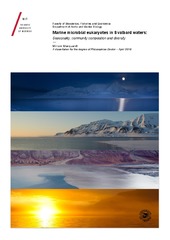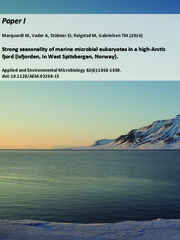| dc.contributor.advisor | Gabrielsen, Tove M. | |
| dc.contributor.author | Marquardt, Miriam | |
| dc.date.accessioned | 2016-10-11T08:30:35Z | |
| dc.date.available | 2016-10-11T08:30:35Z | |
| dc.date.issued | 2016-10-18 | |
| dc.description.abstract | There is an increasing awareness of the importance and diversity of the microbial community in Arctic regions, but their role in the ecosystem is still largely unknown. Sampling was conducted in Svalbard waters with focus on the Adventfjorden-Isfjorden time series station (IsA, West Spitsbergen) that was sampled frequently from December 2011 to December 2012. The community composition of microbial eukaryotes (size: 0.45-10 µm and > 10µm) and their contribution to the vertical particle flux were determined using PCR screening and 454 sequencing of the 18S V4 region amplified from both DNA and RNA. The autotrophs Micromonas pusilla and Phaeocystis pouchetii were widely distributed and active at almost all locations and depths around Svalbard during the polar night and played important roles during the spring bloom at IsA. Small Gyrodinium species were predominant throughout the year. The winter and early-spring communities, in which heterotrophs such as Marine Stramenopiles, Picozoa and the parasitoid Marine Alveolates dominated, were more diverse than the spring and summer/autumn communities. An advective event in March was potentially responsible for a change in the community composition of small eukaryotes. Small cells (< 10 µm) contributed significantly to the vertical flux during autumn and winter, possibly due to increased flocculation and ballasting processes. In contrast, larger and more typical spring bloom taxa (e.g. diatoms) dominated both the water column and sediment traps during spring. Molecular tools not only revealed novel taxa contributing to the vertical export, but also suggested new mechanisms for vertical export exemplified by parasite-host induced transport. These results emphasize the extreme seasonality of Arctic microbial eukaryotic communities driven by the environment (e.g. light and nutrient availability) but point to the necessity of a thorough knowledge of hydrography to fully understand their succession and fate. | en_US |
| dc.description.doctoraltype | ph.d. | en_US |
| dc.description.popularabstract | I disse dager er det et økt fokus på mikrobielle eukaryoters diversitet og betydning i arktiske strøk, men likevel er disse organismenes rolle i økosystemet i all hovedsak ukjent. Prøvetaking ble gjennomført i 2011-2012 på en tidsseriestasjon i Adventfjorden på Svalbard. Marine mikrobielle eukaryoter (< 10 µm) ble undersøkt ved hjelp av Neste-Generasjon Sekvensering. Disse hadde en sterk sesongsuksesjon, med et variert og aktivt samfunn selv under polarnatta. Molekylære metoder avslørte ikke bare nye grupper av marine eukaryoter som bidrar til vertikal karbontransport, men pekte også på nye, potensielle mekanismer for slik eksport, demonstrert ved parasitt-vert-interaksjoner. Dette studiet viser tydelig den ekstreme sesongvariasjonen hos arktiske mikrobielle eukaryotsamfunn, som delvis er et resultat av lysregimet på disse breddegrader. Studiet understreker også betydningen av solid kunnskap om hydrografi for å få en god forståelse for de mikrobielle eukaryotenes suksesjon og skjebne. | en_US |
| dc.description.sponsorship | My research was internally financed by the University Centre in Svalbard. This study is part of the MicroFun project, funded by ConocoPhillips and Lundin Petroleum via their Northern Area Program. Fieldwork was supported by the Arctic Field Grant (RIS 5264 and 5688). | en_US |
| dc.description | The papers II and III of this thesis are not available in Munin. <br>
Paper II: Vader, A., Marquardt, M., Meshram, A. R., Gabrielsen, T. M.: “Key Arctic phototrophs are widespread in the polar night”. Available in <a href=http://dx.doi.org/10.1007/s00300-014-1570-2>Polar Biology 2015, 38(1):13–21. </a>
<br>
Paper III: Marquardt, M., Skogseth, R., Wiedmann, I., Vader, A., Reigstad, M., Cottier, F., Gabrielsen, T. M.: “Fate of marine pelagic protists in an ice-free high arctic fjord (Adventfjorden, West Spitsbergen)”. (Manuscript). | en_US |
| dc.identifier.isbn | 978-82-8266-122-5 | |
| dc.identifier.uri | https://hdl.handle.net/10037/9804 | |
| dc.language.iso | eng | en_US |
| dc.publisher | UiT The Arctic University of Norway | en_US |
| dc.publisher | UiT Norges arktiske universitet | en_US |
| dc.rights.accessRights | openAccess | |
| dc.rights.holder | Copyright 2016 The Author(s) | |
| dc.subject.courseID | DOKTOR-002 | |
| dc.subject | VDP::Mathematics and natural science: 400::Zoology and botany: 480::Marine biology: 497 | en_US |
| dc.subject | VDP::Matematikk og Naturvitenskap: 400::Zoologiske og botaniske fag: 480::Marinbiologi: 497 | en_US |
| dc.title | Marine microbial eukaryotes in Svalbard waters:
Seasonality, community composition and diversity | en_US |
| dc.type | Doctoral thesis | en_US |
| dc.type | Doktorgradsavhandling | en_US |


 English
English norsk
norsk
